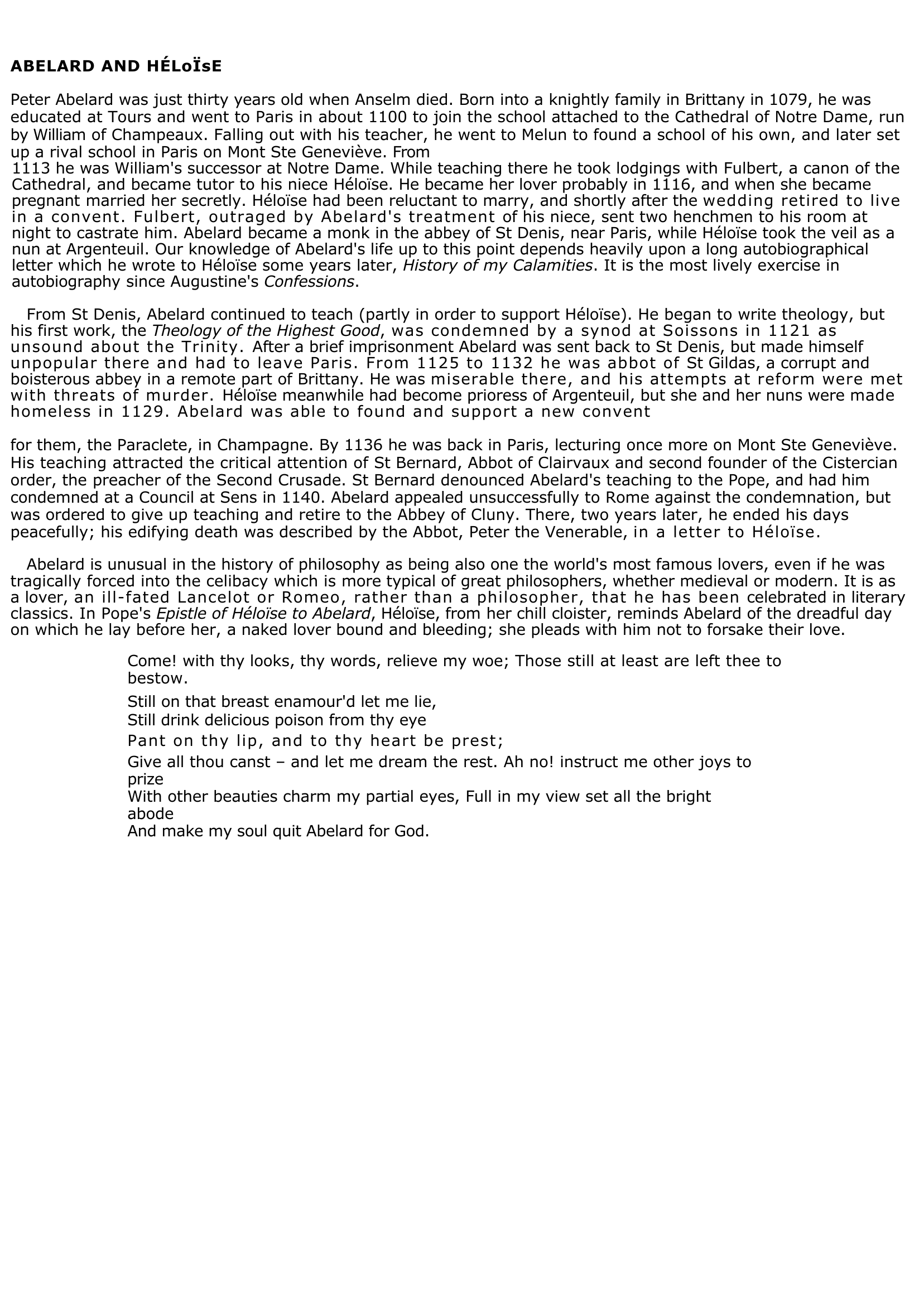Encyclopedia of Philosophy: ABELARD AND HÉLoÏsE
Extrait du document
Peter Abelard was just thirty years old when Anselm died. Born into a knightly family in Brittany in 1079, he was educated at Tours and went to Paris in about 1100 to join the school attached to the Cathedral of Notre Dame, run by William of Champeaux. Falling out with his teacher, he went to Melun to found a school of his own, and later set up a rival school in Paris on Mont Ste Geneviève. From
1113 he was William’s successor at Notre Dame. While teaching there he took lodgings with Fulbert, a canon of the Cathedral, and became tutor to his niece Héloïse. He became her lover probably in 1116, and when she became pregnant married her secretly. Héloïse had been reluctant to marry, and shortly after the wedding retired to live in a convent. Fulbert, outraged by Abelard’s treatment of his niece, sent two henchmen to his room at night to castrate him. Abelard became a monk in the abbey of St Denis, near Paris, while Héloïse took the veil as a nun at Argenteuil. Our knowledge of Abelard’s life up to this point depends heavily upon a long autobiographical letter which he wrote to Héloïse some years later, History of my Calamities. It is the most lively exercise in autobiography since Augustine’s Confessions.
«
ABELARD AND HÉLoÏsE
Peter Abelard was just thirty years old when Anselm died.
Born into a knightly family in Brittany in 1079, he was
educated at Tours and went to Paris in about 1100 to join the school attached to the Cathedral of Notre Dame, run
by William of Champeaux.
Falling out with his teacher, he went to Melun to found a school of his own, and later set
up a rival school in Paris on Mont Ste Geneviève.
From
1113 he was William's successor at Notre Dame.
While teaching there he took lodgings with Fulbert, a canon of the
Cathedral, and became tutor to his niece Héloïse.
He became her lover probably in 1116, and when she became
pregnant married her secretly.
Héloïse had been reluctant to marry, and shortly after the wedding retired to live
in a convent.
Fulbert, outraged by Abelard's treatment of his niece, sent two henchmen to his room at
night to castrate him.
Abelard became a monk in the abbey of St Denis, near Paris, while Héloïse took the veil as a
nun at Argenteuil.
Our knowledge of Abelard's life up to this point depends heavily upon a long autobiographical
letter which he wrote to Héloïse some years later, History of my Calamities.
It is the most lively exercise in
autobiography since Augustine's Confessions.
From St Denis, Abelard continued to teach (partly in order to support Héloïse).
He began to write theology, but
his first work, the Theology of the Highest Good, was condemned by a synod at Soissons in 1121 as
unsound about the Trinity.
After a brief imprisonment Abelard was sent back to St Denis, but made himself
unpopular there and had to leave Paris.
From 1125 to 1132 he was abbot of St Gildas, a corrupt and
boisterous abbey in a remote part of Brittany.
He was miserable there, and his attempts at reform were met
with threats of murder.
Héloïse meanwhile had become prioress of Argenteuil, but she and her nuns were made
homeless in 1129.
Abelard was able to found and support a new convent
for them, the Paraclete, in Champagne.
By 1136 he was back in Paris, lecturing once more on Mont Ste Geneviève.
His teaching attracted the critical attention of St Bernard, Abbot of Clairvaux and second founder of the Cistercian
order, the preacher of the Second Crusade.
St Bernard denounced Abelard's teaching to the Pope, and had him
condemned at a Council at Sens in 1140.
Abelard appealed unsuccessfully to Rome against the condemnation, but
was ordered to give up teaching and retire to the Abbey of Cluny.
There, two years later, he ended his days
peacefully; his edifying death was described by the Abbot, Peter the Venerable, in a letter to Héloïse.
Abelard is unusual in the history of philosophy as being also one the world's most famous lovers, even if he was
tragically forced into the celibacy which is more typical of great philosophers, whether medieval or modern.
It is as
a lover, an ill-fated Lancelot or Romeo, rather than a philosopher, that he has been celebrated in literary
classics.
In Pope's Epistle of Héloïse to Abelard, Héloïse, from her chill cloister, reminds Abelard of the dreadful day
on which he lay before her, a naked lover bound and bleeding; she pleads with him not to forsake their love.
Come! with thy looks, thy words, relieve my woe; Those still at least are left thee to
bestow.
Still on that breast enamour'd let me lie,
Still drink delicious poison from thy eye
Pant on thy lip, and to thy heart be prest;
Give all thou canst – and let me dream the rest.
Ah no! instruct me other joys to
prize
With other beauties charm my partial eyes, Full in my view set all the bright
abode
And make my soul quit Abelard for God..
»
↓↓↓ APERÇU DU DOCUMENT ↓↓↓
Liens utiles
- Encyclopedia of Philosophy: Bentham and James Mill
- Encyclopedia of Philosophy: The Doubt and the Cogito - DESCARTES
- Encyclopedia of Philosophy: THE CRito of Plato
- Encyclopedia of Philosophy: Albert the Great
- Encyclopedia of Philosophy: Sidgwick

































